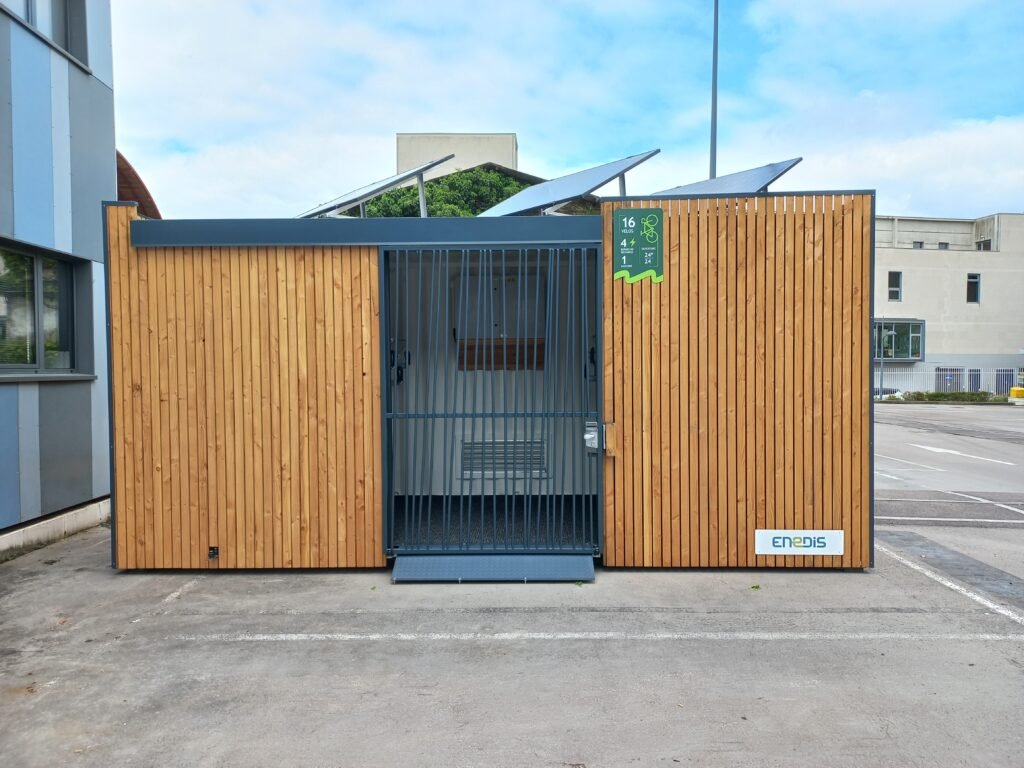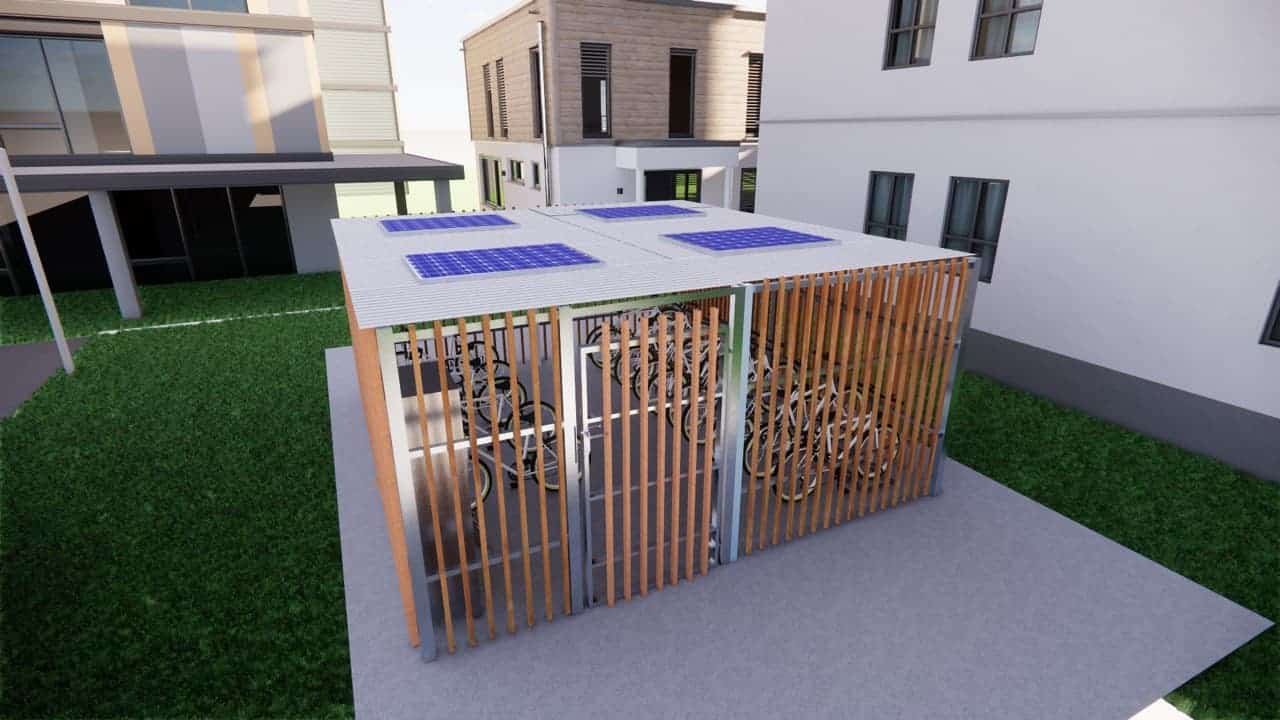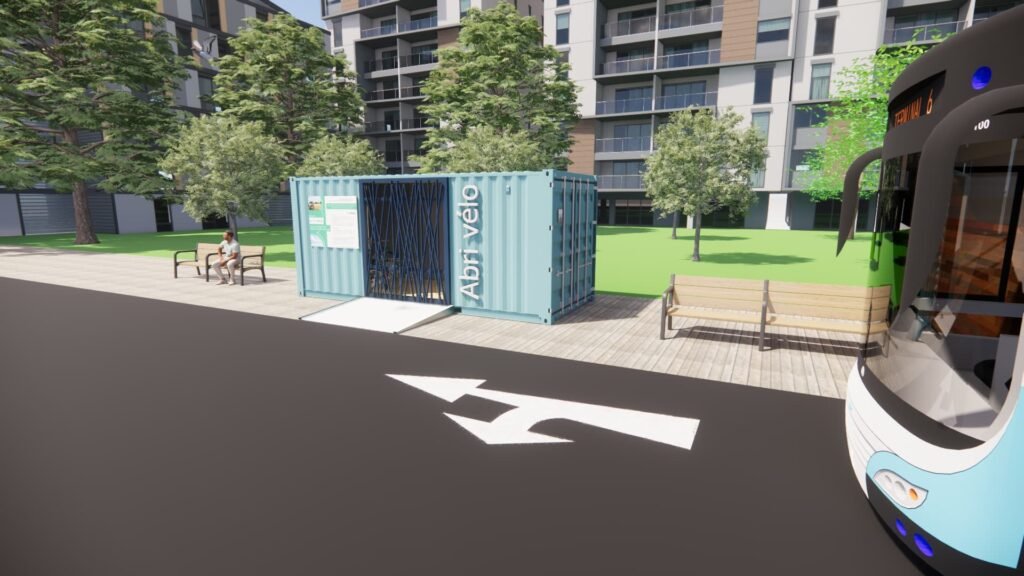Solar-powered bike shelters are emerging as innovative solutions at the heart of modern cities, responding to the growing need for sustainability and urban efficiency. These structures, which use solar energy for lighting or recharging electric bikes, represent a perfect alliance between ecology and functionality. In this article, we explore their role in transforming public spaces into greener, more welcoming areas, highlighting how they promote sustainable urban mobility.
The different types of solar bike shelters
Solar-powered bike shelters are a landmark innovation in sustainable urban planning, offering two main applications: lighting and electric bike charging. Each type offers distinct advantages and features, adapted to different needs and urban contexts.
Solar Bicycle Lighting Shelters :

- Functionality These shelters are equipped with solar panels that power a lighting system, providing safe, reliable light during low-light hours.
- Benefits :
- Enhanced safety Lighting contributes to the safety of parked bikes, deterring vandalism and theft.
- Energy saving By using solar energy, these shelters reduce dependence on non-renewable energy sources and cut electricity costs.
- Features :
- Simple installation Less complex in terms of electrical installation, they do not require earthing.
- Modular design : Can be designed in a variety of styles to blend harmoniously into different urban environments.
Solar Bike Shelters for Electric Bike Charging :
- Functionality These shelters are equipped with solar panels connected to charging stations for electric bikes, providing a self-contained recharging solution.
- Benefits :
- Support for Electric Mobility E-bike: Encourages the use of electric bicycles by providing a convenient and environmentally-friendly recharging source.
- Energy Autonomy : These shelters operate independently of the electricity grid, which is particularly advantageous in areas without easy access to electricity.
- Benefits :
- Features :
- Technical Installation : Requires more elaborate electrical installation, including earthing for safety.
- Compliance with Electrical Standards Must meet strict electrical standards to guarantee safety and efficiency.
- Features :
Installation and Technical Requirements for Solar Bicycle Shelters for Public Structures
Installing solar-powered bike shelters in public spaces requires particular attention to technical details and safety standards, especially when it comes to differentiating between lighting and recharging systems.
Installation of Solar Lighting Shelters :
- Technical simplicity These shelters are generally simpler to install, as they don't require a complex electrical infrastructure. Installation focuses on setting up the solar panels and connected LED lighting system.
- No grounding In contrast to charging systems, the lighting installation does not require earthing, simplifying the process and reducing costs.
- Strategic positioning : It's important to position the shelter so as to maximize exposure to the sun, for optimum efficiency of the solar panels.
- Compliance with safety standards Although less complex, these installations still have to comply with local safety standards, especially in public areas.
Installation of Electric Bike Charging Shelters :
- Electrical Complexity : These shelters require a more elaborate electrical installation, with components such as converters, charge controllers and charging stations.
- Earthing Obligatory Earthing is essential to ensure safety and prevent electrical hazards, especially in public areas with a high flow of people.
- Compliance with electrical standards Installation must comply strictly with current electrical standards to ensure the safety and reliability of the charging system.
- Planning and Approvals Public structures often need to obtain specific approvals or permits for this type of installation, due to its more complex nature and potential impact on the urban environment.
In both cases, it is crucial for public structures to work with qualified professionals to ensure correct and safe installation. Collaboration with local authorities is also essential to ensure that all regulations and requirements specific to the public space are respected. Finally, careful planning is required to integrate these shelters aesthetically and functionally into the urban landscape, taking into account the needs and comfort of users.
An example of a bicycle shelter for Beauchastel town hall
In Beauchastel, an exemplary solar-powered bicycle shelter demonstrates the efficiency and innovation of these structures in a public setting. The shelter combines secure parking for bicycles with an autonomous recharging station for electric bikes, embodying the town's commitment to sustainable mobility.
Key features :
- Recharge capacity: Equipped to charge up to five electric bikes simultaneously.
- Energy Efficiency: Uses high-performance solar panels for optimum energy management.
- Urban IntegrationDesigned to match Beauchastel's aesthetic, offering both functionality and visual appeal.
Local Impact :
- The project has been well received by the community, underlining its usefulness and role in promoting sustainability.
- It serves as a model for other cities, illustrating the practical and environmental benefits of solar bike shelters in urban spaces.
All our solar-powered bicycle shelters.
Frequently asked questions.
What's the main difference between a solar bike shelter for lighting and one for recharging electric bikes?
- The lighting shelter uses solar panels to provide light, while the charging shelter is equipped to power charging stations for electric bikes.
What are the installation requirements for a solar bike shelter?
- Requirements vary according to the type of shelter. Lighting shelters require less electrical infrastructure, while charging shelters require more complex installation, including grounding.
How many bikes can be accommodated and recharged in these shelters?
- Capacity varies according to model and customization, from a few bikes to several dozen.
How durable are the solar panels used in these shelters?
- Solar panels are designed for long-term durability and performance, often with a lifespan of several decades.
Do solar bike shelters require a lot of maintenance?
- Maintenance is generally minimal, concentrating on cleaning the solar panels and regularly inspecting the electrical components.
How do these shelters fit into the urban landscape?
- The shelters are designed to harmonize aesthetically with the urban environment, and can be customized in terms of design and size.
Are there any subsidies or financial assistance available for the installation of these shelters?
- This depends on the region and local policies. We recommend consulting the subsidy programs available for sustainable infrastructure. You can also contact us to find out more.
What are the safety considerations for installing these shelters in public spaces?
- Safety is a priority, involving compliance with electrical standards, professional installation, and possibly additional safety measures for charging shelters.
How do solar shelters contribute to the community's sustainability objectives?
- They encourage the use of bicycles, reduce dependence on fossil fuels, and support green mobility initiatives.
Can shelters be customized to meet specific needs?
- Yes, it's possible to customize shelters according to capacity, design and specific features required.
Advantages of solar bike shelters
Solar-powered bike shelters offer a range of significant advantages, particularly for urban and public spaces:
- Durability : Constructed from robust materials and designed to withstand the elements, these shelters guarantee a long service life, minimizing the need for frequent maintenance.
- Ecological aspect The use of solar energy for lighting or recharging electric bikes reduces dependence on fossil fuels, contributing to a cleaner, more sustainable urban environment.
- Ease of use : Their intuitive design ensures accessibility and ease of use for all users, encouraging the use of bicycles as an environmentally-friendly means of transport.
Conclusion
Solar-powered bike shelters represent a remarkable fusion of functionality and sustainability, offering an environmentally-friendly and practical solution for urban bike parking and recharging needs.
Their integration into public spaces not only meets the immediate needs of cyclists, but also symbolizes a commitment to greener, more sustainable practices. We strongly encourage communities and public structures to consider installing these shelters, not only to improve their mobility infrastructure, but also to play an active role in promoting a more sustainable urban future. The adoption of these solar bike shelters is a key step towards creating greener, cleaner and more welcoming cities for all.








